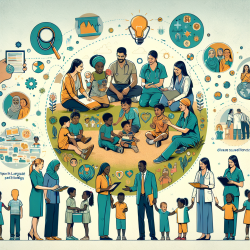Building Core Capacities: Lessons from Global Health Strategies for Child Development
In the realm of speech-language pathology, the quest for improving child outcomes is relentless. As practitioners, we often look for innovative strategies and data-driven methods to enhance our practice. One area that provides a wealth of insights is global health, particularly the strategies employed by the U.S. Department of Defense (DoD) in disease surveillance and response. By examining these strategies, we can glean valuable lessons that can be applied to our work with children.
The Power of Partnership and Trust
The research article titled "International Health Regulations (2005) and the U.S. Department of Defense: Building Core Capacities on a Foundation of Partnership and Trust" sheds light on the importance of collaboration and trust in building effective systems. The DoD's Global Emerging Infections Surveillance and Response System (GEIS) is a testament to the power of partnerships. By working closely with host countries, the DoD has developed a robust network capable of identifying and responding to public health threats.
For speech-language pathologists, this highlights the importance of building strong relationships with stakeholders, including families, educators, and healthcare providers. By fostering trust and collaboration, we can create a supportive environment that enhances the effectiveness of our interventions.
Data-Driven Decision Making
One of the key components of the DoD's strategy is the use of data to drive decision-making. The GEIS network relies on electronic surveillance systems to collect and analyze data, allowing for timely and accurate responses to emerging threats. This data-driven approach ensures that interventions are based on the latest evidence and can be adjusted as new information becomes available.
In our practice, adopting a data-driven mindset can significantly improve outcomes for children. By systematically collecting data on child progress and using it to inform our interventions, we can tailor our approaches to meet the unique needs of each child. This not only enhances the effectiveness of our interventions but also provides a clear picture of the child's development over time.
Capacity Building and Training
The DoD's emphasis on capacity building and training is another area where we can draw parallels. By investing in the development of local capacities, the DoD ensures that host countries are equipped to handle public health challenges independently. This approach is particularly relevant in speech-language pathology, where ongoing professional development is crucial for staying abreast of the latest research and techniques.
As practitioners, we should prioritize continuous learning and skill development. By participating in workshops, conferences, and training programs, we can enhance our knowledge and skills, ultimately leading to better outcomes for the children we serve.
Conclusion
The strategies employed by the DoD in global health offer valuable lessons for speech-language pathologists. By focusing on partnership, data-driven decision-making, and capacity building, we can enhance our practice and improve outcomes for children. As we strive to create supportive and effective interventions, let us draw inspiration from these global health strategies and continue to seek innovative ways to support the development of the children we serve.
To read the original research paper, please follow this link: International Health Regulations (2005) and the U.S. Department of Defense: building core capacities on a foundation of partnership and trust.










